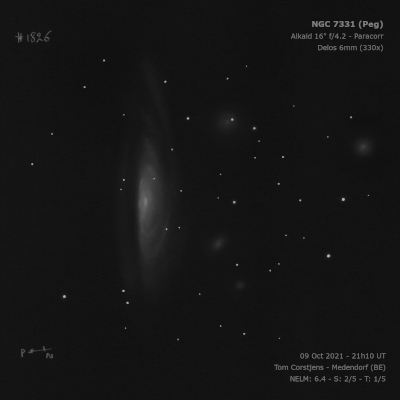
William Herschel discovered NGC 7331 = H I-53 = h2172 on 6 Sep 1784 (sweep 258) and recorded "pB, cL, E, lbM." His position is 10' too far south-southeast. On 13 Sep 1784 (sweep 269), he noted "vB, cL, mE, mbM, r." JH reported "vB; pL; smbM; E 70° np to sf; 90" l, 30" br. If I. 53, the working list 9' out in PD [it is]."
George Stoney, LdR's assistant on 17 Aug 1849, logged "the preceding edge is well defined [dust lane] and Nucl near it. I strongly suspected an eF branch [spiral arm] from south end round following and north and then preceding of preceding edge." A month later he confirmed "appendage preceding certain, following branch suspected, 4 knots [companions] following, one preceding seen by Lord R to consist of 4 or 5 stars [wrong]." The sketch on Plate XXX, fig 39, clearly shows the dust lane along the major axis.
200/250mm - 8" (8/28/81): very bright, large, nucleus bulge, very elongated. Two extremely faint companions to the east are just visible.
300/350mm - 13.1" (7/27/84): very bright, very elongated 3:1 NNW-SSE, 9'x2.5', very bright elongated core, substellar nucleus. The west side has a sharper edge due to dust. Four (background) companions are close following with the brightest three NGC 7335 3.5' ENE, NGC 7337 5.2' SE, NGC 7336 5.3' NE and NGC 7340 8.1' E of center. Stephan's Quintet lies 30' SSW. NGC 7331 is the brightest in a small group including NGC 7320 (in Stephan's Quintet).
400/500mm - 18" (8/1/08): The sharp light cut-off (dust lane) was evident, running along the west side of the galaxy, and the outer halo had subtle structure and variations in brightness that suggested spiral structure.
600/800mm - 24" (7/21/12): at 322x this showpiece galaxy appeared very bright, very elongated 3:1 NNW-SSE, ~9'x3'. Contains a very bright, elongated core that is sharply concentrated with an intense stellar nucleus. The galaxy exhibits subtle spiral structure in the outer halo and the brighter edge of the inner western arm is sharply defined as it shoots north. Just west of this arm the light drops off sharply due to a long dust lane and the dim glow of the outer halo is clearly visible west of the lane. Arm structure is also evident at the north and south ends of the central region. The four background companions to the east fit snugly in the field.
900/1200mm - 48" (10/24/14): at 488x, the long dust lane along the west side (running N-S) was very evident as the galaxy is sharply cut off at the bright edge of a thin inner spiral arm (the arm itself was not resolved). A clearly visible outer spiral arm curves sharply counterclockwise around the south side of the halo and shoots directly north. It continues or merges into a fairly narrow arm just west of the dust lane and extends north of the central region on the west side.
Notes by Steve Gottlieb